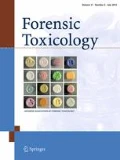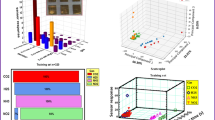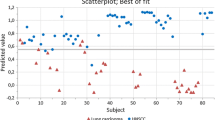Abstract
The present work represents a novel approach using earwax (cerumen) for the evaluation of the smoking status with regards to tobacco use/exposure. The method utilizes the difference in the concentration profiles of nicotine and its related compounds in earwax to discriminate among non-, passive, and active smokers. Earwax samples were collected from three study groups (non-, passive, and active smokers) and subjected to analysis by headspace gas chromatography–mass spectrometry. The nicotine levels in earwax were much lower than cotinine levels, even for active smokers; however, it was reported that the nicotine levels in scalp hair were much higher than the cotinine levels. Therefore, it is obviously correct that earwax is protected from external contamination to a larger extent than expected. The concentration profiles of nicotine and its related compounds (o-nicotine, cotinine, and anabasine) in the analyzed earwax samples were treated by data mining techniques. It was possible to discriminate the studied groups using the evolutionary tree (evtree) algorithm and support vector machine discriminant analysis as the statistical models with the best discrimination accuracies of 96.7 and 95.0%, respectively. The analytical method applied requires no sample pretreatment which makes it easy, fast, and a low-cost alternative method to those employing other biological matrices, such as blood, urine, and hair. The earwax, which is considered a neglected body secretion, is a useful tool to determine the exposure to tobacco smoke noninvasively and without the influence of external contamination.





Similar content being viewed by others
References
Hu Q, Hou H (2015) Tobacco smoke exposure biomarkers. CRC Press, Boca Raton
Haufroid V, Lison D (1998) Urinary cotinine as a tobacco smoke exposure index: a minireview. Int Arch Occup Environ Health 71:162–168
Martinet Y, Wirth N (2013) Respiratory medicine. European Respiratory Society, Sheffield
Doctor PB, Gokani VN, Kulkami PK, Parikh JR, Saiyed HN (2004) Determination of nicotine and cotinine in tobacco harvester’s urine by solid-phase extraction and liquid chromatography. J Chromatogr B 802:323–328
Hukkanen J (2005) Metabolism and disposition kinetics of nicotine. Pharmacol Rev 57:79–115
Kim I, Huestis MA (2006) A validated method for the determination of nicotine, cotinine, trans-3′-hydroxycotinine, and norcotinine in human plasma using solid-phase extraction and liquid chromatography-atmospheric pressure chemical ionization-mass spectrometry. J Mass Spectrom 41:815–821
Benowitz NL (2009) Pharmacology of nicotine: addiction, smoking-induced disease, and therapeutics. Annu Rev Pharmacol Toxicol 49:57–71
Schwartz RS, Benowitz NL (2010) Nicotine addiction. N Engl J Med 362:2295–2303
Skarping G, Willers S, Dalene M (1988) Determination of cotinine in urine using glass capillary gas chromatography and selective detection, with special reference to the biological monitoring of passive smoking. J Chromatogr 454:293–301
Haley NJ, Sepkovic DW, Hoffman D (1989) Elimination of cotinine from body fluids: disposition in smokers and non-smokers. Am J Public Health 79:1046–1048
Willers S, Skarping G, Dalene M, Skerfving S (1995) Urinary cotinine in children and adults during and after semiexperimental exposure to environmental tobacco smoke. Arch Environ Health 50:130–138
Jacob P, Shulgin AT, Yu L, Benowitz NL (1992) Determination of the nicotine metabolite trans-3 hydroxycotinine in urine of smokers using gas chromatography with nitrogen-selective detection or selected ion monitoring. J Chromatogr B 583:145–154
Jacob P III, Yu L, Liang G, Shulgin AT, Benowitz NL (1993) Gas chromatographic-mass spectrometric method for determination of anabasine, anatabine and other tobacco alkaloids in urine of smokers and smokeless tobacco users. J Chromatogr 619:49–61
Jacob P III, Yu L, Shulgin AT, Benowitz NL (1999) Minor tobacco alkaloids as biomarkers for tobacco use: comparison of users of cigarettes, smokeless tobacco, cigars, and pipes. Am J Public Health 89:731–736
Florescu A, Ferrence R, Einarson T, Selby P, Soldin O, Koren G (2009) Methods for quantification of exposure to cigarette smoking and environmental tobacco smoke: focus on developmental toxicology. Ther Drug Monit 31:14–30
Boumba VA, Ziavrou KS, Vougiouklakis T (2006) Hair as a biological indicator of drug use, drug abuse or chronic exposure to environmental toxicants. Int J Toxicol 25:143–163
Prokop-Prigge KA, Thaler E, Wysocki CJ, Preti G (2014) Identification of volatile organic compounds in human cerumen. J Chromatogr B 953–954:48–52
Shokry E, de Oliveira AE, Avelino MA, de Deus MM, Filho NR (2017) Earwax: a neglected body secretion or a step ahead in clinical diagnosis. J Proteom. doi:10.1016/j.jprot.2017.03.005
Shokry E, Marques JG, Ragazzo P, Pereira NZ, Filho NRA (2017) Earwax as an alternative specimefor forensic analysis. Forensic Toxicol. doi:10.1007/s11419-017-0363-z
Guest JF, Greener MJ, Robinson AC, Smith AF (2004) Impacted cerumen: composition, production, epidemiology and management. QJM 97:477–488
De Giovanni N, Fucci N (2013) The current status of sweat testing for drugs of abuse: a review. Curr Med Chem 20:545–561
Stepanov I, Feuer R, Jensen J, Hatsukami D, Hecht SS (2006) Mass spectrometric quantitation of nicotine, cotinine, and 4-(methylnitrosamino)-1-(3-pyridyl)-1-butanol in human toenails. Cancer Epidemiol Biomark Prev 15:2378–2383
Rebagliato M, Bol F, Florey CV, Jarvis MJ, Pérez-Hoyos S, Hern I, Avi MJ (1998) Variations in cotinine levels in smokers during and after pregnancy. Am J Obstet Gynecol 178:568–571
Hu Q, Hou H (2015) Guidance for industry bioanalytical method validation by the food and drug administration. Tobacco smoke exposure biomarkers. CRC Press, Boca Raton, pp 247–264
Meng J, Shi L, Luan Y (2014) Plant microRNA—target interaction identification model based on the integration of prediction tools and support vector machine. PLoS One 9:e103181. doi:10.1371/journal.pone.0103181
Christmann A, Fischer P, Joachims T (2002) Classification based on the support vector machine, regression depth, and discriminant analysis. In: Härdle W, Rönz B (eds) Compstat. Proceedings in computational statistics. Springer, Heidelberg, pp 225–230
Grubinger T, Zeileis A, Pfeiffer KP (2014) evtree: evolutionary learning of globally optimal classification and regression trees in R. J Stat Softw. doi:10.18637/jss.v061.i01
Scholkopf B, Burges CJC, Smola AJ (eds) (1999) Advances in kernel methods. Support vector learning. MIT Press, Cambridge, pp 1–376 (ISBN 0–262–19416–3)
Ben-Hur A, Weston J (2010) A user’s guide to support vector machines. Methods Mol Biol 609:223–239
Meier TB, Desphande AS, Vergun S, Nair VA, Song J, Biswal BB (2012) Support vector machine classification and characterization of age-related reorganization of functional brain networks. Neuroimage 60:601–613
Fuji J, Higashi A, Matsuda I, Nakano M (2001) Measurement of concentrations of nicotine and cotinine in maternal and neonatal hair. Jpn J Clin Pharmacol Ther 32:119–125
Tsuji M, Mori Y, Kanda H, Ito T, Hidaka T, Kakamu T, Kumagai T, Hayakawa T, Osaki Y, Fukushima T (2013) Development of simple HPLC/UV with a column–switching method for the determination of nicotine and cotinine in hair samples. Health 5:687–694. doi:10.4236/health.2013.54091
Acknowledgements
We wish to acknowledge Coordenação de Aperfeiçoamento de Pessoal de Nível Superior (CAPES), for the research fund provided within the postdoctoral program (PNPD) (Grant Number 1516965) for the first author, Conselho Nacional de Desenvolvimento Científico e Tecnológico (CNPq) for a research productivity Grant to Nelson Roberto Antoniosi Filho and ‘‘Fundação de Apoio à Pesquisa (FUNAPE) for management of financial resources. We also wish to acknowledge the contribution of the study participants. This work is a part of the research project “Chemical analysis composition of earwax in human and other animals” fully funded by CAPES.
Author information
Authors and Affiliations
Corresponding author
Ethics declarations
Conflict of interest
The authors declare that they have no conflict of interest.
Ethical approval
All procedures performed in studies involving human participants were in accordance with the ethical standards of the institutional and/or national research committee and with the 1964 Helsinki declaration and its later amendments or comparable ethical standards. Informed consent was obtained from all individual participants included in the study.
Rights and permissions
About this article
Cite this article
Shokry, E., de Oliveira, A.E., Avelino, M.A.G. et al. Earwax: an innovative tool for assessment of tobacco use or exposure. A pilot study in young adults. Forensic Toxicol 35, 389–398 (2017). https://doi.org/10.1007/s11419-017-0370-0
Received:
Accepted:
Published:
Issue Date:
DOI: https://doi.org/10.1007/s11419-017-0370-0




